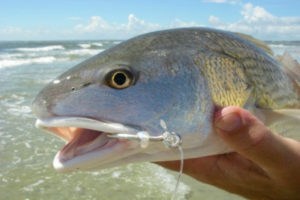Recreational Anglers Get Help Combating Post-Release Mortality from Partnership of Fishery Managers
from The Fishing Wire

Red drum with circle hook in lip.
Red drum with circle hook in lip. Photo courtesy of Capt. Spud Woodward.
NOAA Fisheries, the Atlantic States Marine Fisheries Commission, and Atlantic state agencies partner to make circle hooks, descending devices more accessible to anglers.
No one, especially recreational anglers, likes to see a fish float away or sink to the bottom dead. That’s why NOAA Fisheries Recreational Fishing Initiative, the Atlantic States Marine Fisheries Commission (ASMFC), and the Atlantic states are working together to help more fish survive when released by recreational anglers.
Fish mortality has historically been high in some of our most iconic fisheries. Advances in fishing gear technology have, in recent years, helped alleviate some of its leading causes. Two of the most effective tools are fish descending devices and circle hooks.
Descending devices help return fish to the depth—and pressure—where they were caught. This relieves problems caused by barotrauma, a condition resulting from rapid pressure changes. Barotrauma can make it hard for fish to swim and can cause swelling of their organs.
Circle hooks help anglers hook a fish in the lip or jaw, reducing damage from hooking fish in the gills, stomach, or other vital organs.
Many recreational anglers are embracing these technologies. Fishery managers see benefits when more anglers adopt catch and release best practices.
NOAA Fisheries recently worked with ASMFC to make these tools more easily available and keep our nation’s fishery resources healthy. With funds provided by NOAA Fisheries Recreational Fishing Initiative, the Commission distributed 61,000 circle hooks and more than 1,000 descending devices to state marine fishery agencies from Florida to New England. This project will help recreational anglers limit their impact on the resources they cherish. It has also strengthened the partnership between state and federal fishery managers.
Bob Beal, ASMFC Executive Director said “ASMFC and its member states are committed to working with our federal partners and stakeholders to reduce post-release mortality. Circle hooks and descending devices, in combination with angler education, can be important components of a fishery management program. Given the impact of using these tools are difficult to quantify and are largely dependent on angler experience, they should be used in concert with other management measures to maximize their conservation benefits to the resource.”
“Accounting for and reducing the impact of recreational discards in a stock assessment is an enormous fishery management challenge,” says Dr. Luiz Barbieri, Program Administrator, Marine Fisheries Research at Florida Fish and Wildlife Research Institute. “Anything that can help us reduce the uncertainty of recreational discards in a stock assessment and improve management decisions is a welcome tool in the toolbox. This partnership is an extremely valuable step in improving the management of our recreational fisheries.”
Russell Dunn, the National Policy Advisor for Recreational Fisheries at NOAA Fisheries continues, “It was a natural collaboration to address an issue important to anglers and managers that can have a real impact on maintaining healthy fish stocks and improving recreational fishing opportunities. We were glad to be able to contribute and appreciate their partnership.”
Catch and release fishing is not only an American pastime, but a great conservation strategy if done correctly. Actions anglers take before, during, and after a fish is caught can improve its chances of survival, keep fish stocks healthy, and keep anglers fishing.